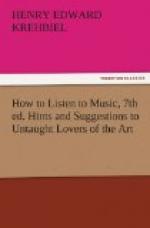II
Recognition of Musical Elements
[Sidenote: The nature of music.]
Music is dual in its nature; it is material as well as spiritual. Its material side we apprehend through the sense of hearing, and comprehend through the intellect; its spiritual side reaches us through the fancy (or imagination, so it be music of the highest class), and the emotional part of us. If the scope and capacity of the art, and the evolutionary processes which its history discloses (a record of which is preserved in its nomenclature), are to be understood, it is essential that this duality be kept in view. There is something so potent and elemental in the appeal which music makes that it is possible to derive pleasure from even an unwilling hearing or a hearing unaccompanied by effort at analysis; but real appreciation of its beauty, which means recognition of the qualities which put it in the realm of art, is conditioned upon intelligent hearing. The higher the intelligence, the keener will be the enjoyment, if the former be directed to the spiritual side as well as the material.
[Sidenote: Necessity of intelligent hearing.]
So far as music is merely agreeably co-ordinated sounds, it may be reduced to mathematics and its practice to handicraft. But recognition of design is a condition precedent to the awakening of the fancy or the imagination, and to achieve such recognition there must be intelligent hearing in the first instance. For the purposes of this study, design may be held to be Form in its primary stages, the recognition of which is possible to every listener who is fond of music; it is not necessary that he be learned in the science. He need only be willing to let an intellectual process, which will bring its own reward, accompany the physical process of hearing.
[Sidenote: Tones and musical material.]
Without discrimination it is impossible to recognize even the crude materials of music, for the first step is already a co-ordination of those materials. A tone becomes musical material only by association with another tone. We might hear it alone, study its quality, and determine its degree of acuteness or gravity (its pitch, as musicians say), but it can never become music so long as it remains isolated. When we recognize that it bears certain relationships with other tones in respect of time or tune (to use simple terms), it has become for us musical material. We do not need to philosophize about the nature of those relationships, but we must recognize their existence.




